Container Growing General
The Edible Container Garden (Fresh Food From Tiny Spaces) – Michael Guerra – Gaia Books Ltd (UK) 2000 ISBN 1 85675 089 2 – Good general book on container gardening, how to make and use containers as well as details on individual vegetables, it even makes reference to Permaculture. Chapter one covers getting started, including – design principles, watering strategies, choosing containers, low maintenance gardening. Chapter two talks about growing spaces including: tools, garden structures, pruning and training, weeds, pests, diseases and companion planting. Chapter three discusses the best vegetables, herbs, fruits and flowers for small spaces. Lots of colour photos.
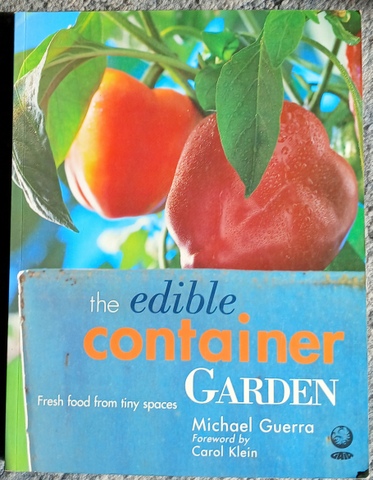
Patio Produce – Paul Peacock – Spring Hill (UK) 2009 ISBN 978 1 905862 28 3 – Lots of good stuff about growing individual vegetables, fruit and herbs on your patio or small outdoor space as well as how to plan and get the best out of your patio farm. Obviously, the section on the patio gardener’s year needs to be adjusted to fit in with the seasons here in Aus. Chapter one covers the environment of the patio including why bother, what pots and containers you will need, the best way to grow patio plants, finding novel places to grow and how much you can grow. Chapter two covers planning including tools, trays and propagation, planning crops and growing fruit. Chapter three covers the differences between growing in pots and growing in the ground. Chapter four covers the gardener’s year, Chapter five covers the intricacies of growing 39 vegetables. Chapter six covers 15 varieties of fruit and chapter seven covers 24 herbs. The book has no photos and only a few line drawings.
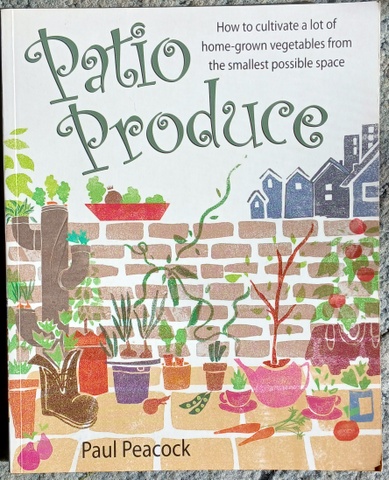
Incredible Vegetables from Self Watering Containers – Edward C. Smith – Storey Publishing (US) 2006 ISBN 978 1 58017 556 2 – This book covers how to make and use self-watering pots, what potting soil to use and which vegetables to plant in them to get the best yield. Although the emphasis seems to be on using commercial self-watering pots, the data is good just team it up with the information on self-watering pots on this site and you’re away! The book has three parts, part one covers growing veggies in containers, containers, growing media, tools and accessories. Part two is called ‘Putting it all Together’ and talks about getting started, sowing seeds, designing for containers, caring for container gardens, pests and diseases, harvesting and actions prior to (US) winter. Part three contains a review of 43 vegetables (from 1 to 3 pages each) talking about the type of container to use, how to grow it, how to eat it and pest and disease issues. Also covered are 20 herbs and 7 edible flowers. The book has lots and lots of colour photos.
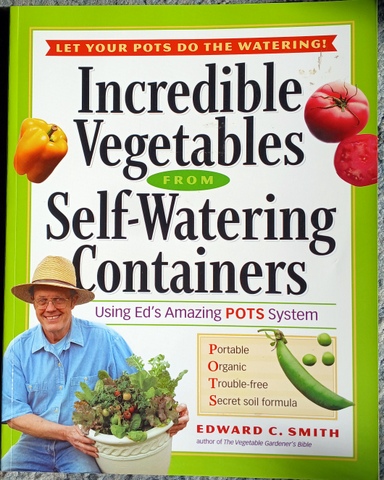
From Container to Kitchen – D.J.Herda- New Society Publishers (CAN) 2010 ISBN 978 0 86571 665 0 – This one bills itself as the “complete guide to the no-yard garden”. It covers, among other things, selecting the right container and location, optimising soil nutrients, managing light, water and humidity, choosing fruit & veggies and treating pests and diseases. While not being a big book, it has lots of good information. There is a group of colour photos in the centre of the book, with black and white photos scattered throughout the book where appropriate.

Crops in Pots (Part of the “Green Guides” series of books) – Rachelle Straus – Flame Tree Publishing (UK) 2011 ISBN 978 1 84786 719 3 – This book has a small amount of information on a lot of subjects. It covers why you would want to grow food in containers, how to get started, what to grow and how to grow it, harvesting the produce, pests and diseases. There are also sections on the specifics of growing vegetables, salads, fruits, herbs and edible flowers as well as a section on frugal gardening. There are lots of colour photos.

Grow Your Own Vegetables in Containers (Also called “Organic Crops in Pots”) – Deborah Schneebeli-Morrell – Cico Books (US) 2009 ISBN 978 1 907030 06 2 – The book starts out with general principles of organic gardening and how to get started and then goes into specifics of how to set up over 30 different types of gardens in pots. Some examples are sweet basil in a clay pot, red lettuce and shiso in metal tins, potatoes in woven sacks and eggplant in a rubber bucket, lots of colour photos.
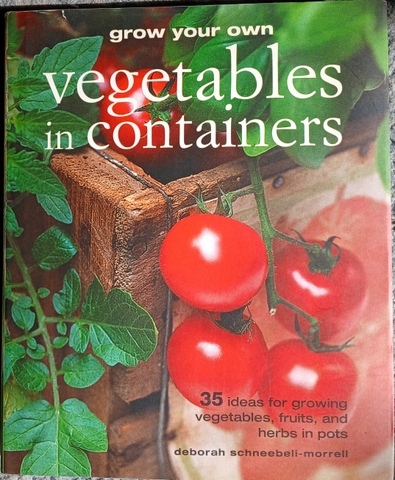
Grow Your Own Crops in Pots – Kay Maguire – Michael Beazley (Royal horticultural Society) UK 2013 ISBN 978 1 84533 686 8 – The book is broadly broken up into sections covering fruit, vegetables, herbs and edible flowers. The book starts with a discussion of general planting techniques, planning, nurturing and protecting your crops in pots. It follows with a comprehensive listing the plants in each section, how to plant them in containers and how to keep them happy. Each plant only gets a page or two but there are a large number of plants covered. Lots and lots of colour photos.
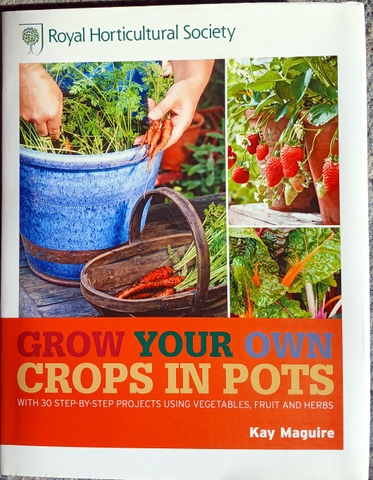
Permaculture in Pots (how to grow food in small urban spaces) – Julie Kemp – Permanent Publications (UK) 2012 ISBN 978 1 85623 097 1 – This book is also set out on the one-month-per-chapter principle. The stat of the book covers general principles and techniques of organic growing and permaculture. Then each chapter/month starts out with what is growing on her balcony that month and what food growing related things can be done during the month. Following is a few pages of discussion about a specific technique or project and the chapter is wound up with a page on the “herb of the month”. Lots of colour photos.
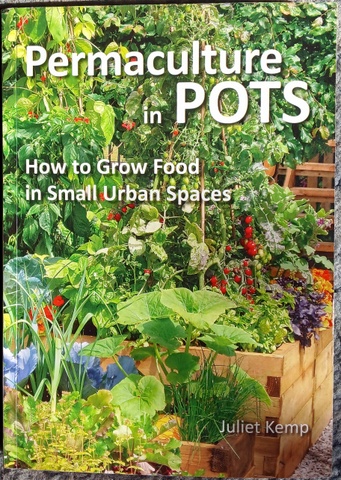
Pot It, Grow It, Eat It – Kathryn Hawkins – New Holland Publishers (UK) 2010 ISBN 978 1 84773 665 9 – The start of the book covers the practicalities of container gardening and getting started (seeds, tools required, feeding and watering, pest control). The main part of the book is made up of monographs on over 45 vegetables, herbs and fruits. Each monograph discusses varieties and general comments, how to plant and where to site seedlings, maintenance requirements, potential problems such as pests and diseases that may be a problem, harvesting, storing and freezing the produce. At the end of the book there are 25 recipes using produce discussed earlier. The book has lots of colour photos.
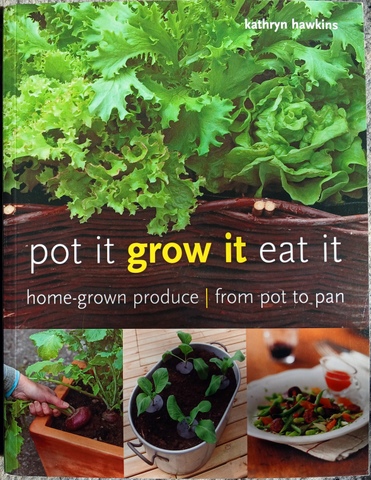
Crops in Pots – Bob Parnell – Hamlyn (UK) 2007 ISBN 978 0 600 61551 4 – The book is set out like a recipe book, the first section being ‘getting started’ followed by ‘starters’, ‘main courses’ and (of course!) desserts, with a final section entitled ‘what to grow’. The first section covers the basics like why do it, siting and grouping containers, choosing containers and compost, propagation, watering, mulching, feeding, pests and diseases. Each section covers a page or too so not vast amounts of details. The rest of the book covers a series of small scale growing projects (12 starters, 26 main courses and12 desserts) and the information on each project is set out over two to three pages, with a list of what is needed to construct the project (‘ingredients’) and construction details (‘method’) and at least one colour photo. The last ‘what to grow’ section gives a paragraph on various vegetables, fruit, herbs and edible flowers. The book has lots of colour photos.
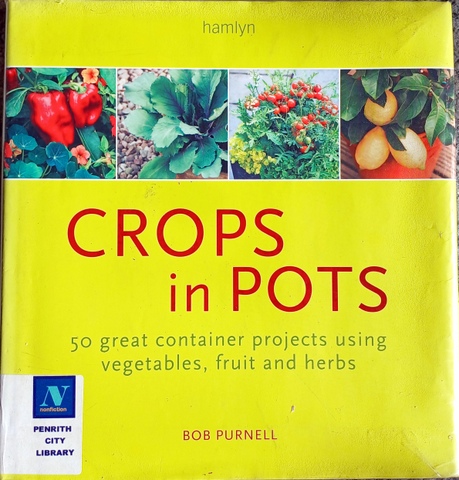
Window-box Allotment – Penelope Bennett – Frances Lincoln Ltd (UK) 2012 ISBN 978 0 7112 3173 3 – After a short introduction on how window boxes can grow veggies, fruit, spices and herbs and how they are perfect for the elderly, children and the disabled, the book is broken up into twelve chapters, one for each month of the year. Chapters vary in size between 6 pages (September) and 14 pages (October). The content of each month varies, but generally contains information on seeds and plants grown during the month, details on thinks like wormeries and stores of the authors experiences. The book has no photos, but some coloured line drawings.
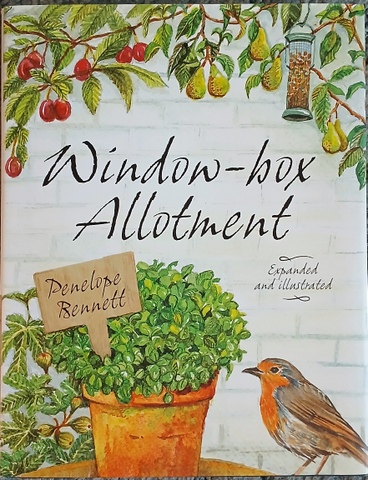
Container Growing Plus (small plots, raised beds etc.)
Grow Your Own Fruit and Veg in Pots, Plots or Growbags – Steve Ott, Emma Rawlings & Roxanne Warwick – Foulsham Books (UK) 2008 ISBN 978 0 572 03494 8 – This is set out as an A to Z guide to growing vegetables, fruit and herbs with 1 or 2 pages per plant including varieties, growing tips ie how to sow, plant and grow on. Entries cover 37 vegetables, 13 herbs and 15 fruits. How to grow the plant in question in containers plus preparation and cooking, storing and freezing and a recipe or two is covered. Good for what it is bearing in mind it is written for the UK experience so that planting times will need to be adjusted. Lots and lots of colour photos.
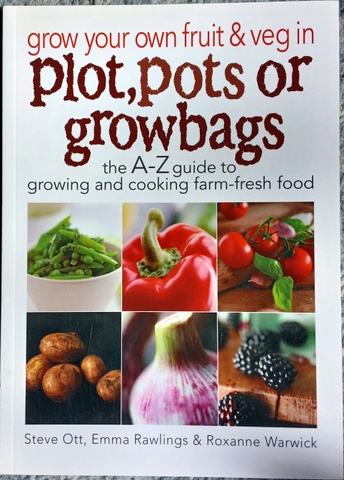
Vegetables for Small Gardens and Containers – Peter De Vaus – Hyland House Publishing (AUS) 1991 ISBN 0 947062 37 8 – This book covers location and planning of veggies, tools, crop rotation, preparation and planting, pest and disease control and harvesting and storage of your veggies. A good book for small scale growers and one of the first to cover container growing veggies seriously. There are sixteen chapters between two and fourteen pages long. Chapter one covers why do it, chapter two planning, chapter three tools required, chapter four understanding soils, chapter five feeding plants, chapter six mulches and watering, chapter seven crop rotation and chapter eight seed sowing. Chapter nine covers seed and seedlings, chapter ten pests and diseases, chapter eleven, protecting your plants, chapter twelve weeds, chapter thirteen gives general comments on growing vegetables in containers and chapter fourteen gives an A to Z of how to grow 67 vegetables. Chapter fifteen discusses harvest and storage; Chapter sixteen gives a series of sowing guides applicable to Aus. The book has 5 sets of colour plates distributed throughout the book plus some B&W photos and line drawings.

Crops in Tight Spots – Alex Mitchell – Kyle Books (UK) 2019 ISBN 978 085783 592 5 – Alex has a number of books out, some of which also reside in my library such as ‘Rurbanite’, ‘The Edible Balcony’ (not to be confused with Indira Naidoo’s book of the same name) and ‘Gardening on a Shoestring’. The main part of the book provides a series of projects, plan and information on individual edible plants designed around: Ledges and Sills; Terraces and Courtyards; Roofs and Balconies; Small Gardens, and Other Awkward Spots. There is also a chapter on ‘Which Crop Where’ and one on pests and diseases. She does refer to Permaculture at a number of points in the book. The book has lots of colour photos.
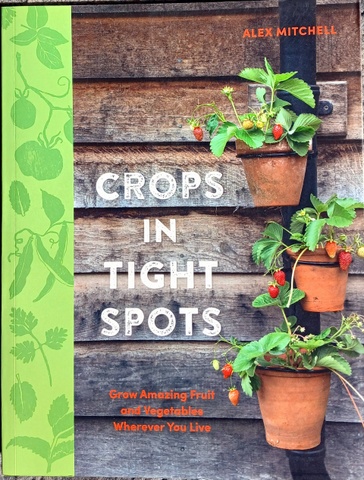
Edible Spots & Pots – Stacey Hirvela – Rodale Press (US) 2014 ISBN 978 1 60961 959 6 – The book has six chapters, The first one, Edible Pots, talks about growing vegetables in containers and chapter two, Edible spots, talks about growing crops in raised beds. Chapter three, Spots & Pots Gardening School’ covers the basics like seed raising, watering crops, fertilising including composting, staking and pruning, pests and diseases. Chapter four, Spots and pots projects gives details of a series of projects under the headings ‘bamboo’ eg making a bamboo trellis & tripod, ‘Fabric’ eg making a fabric grow bag & planting hammock, ‘Metal’ eg making a mesh tower & tomato ring, and ‘Wood’ eg making a deck corner shelf and stacked pot planter. Chapter five ‘Thriller, Filler, Chiller and Spiller’ list different combinations of plants that can be grow together. Chapter six is a’ Plant Encyclopedia’ giving information on 24 annual vegetables, 5 perennial vegetables, and 27 herbs and edible flowers. Each vegetable entry covers the plant’s growing habits, how to start it off, the season it grows (in the US), when to harvest, water and light requirements, recommended varieties, space-to-yield ratio, plot free pointers and garden role. The plant has no photos but lots of line drawings.

Vegetable, Fruit and Herb Growing in Small Spaces – John Harrison – Constable & Robertson Ltd (UK) 2010 ISBN 978 0 7160 2245 9 – This is a small book, slightly larger in size than a standard paperback and 143 pages plus glossary and index and it does not contain a great deal of detail. The first chapter, What to Grow Where, provides various ideas for growing food in small spaces, like containers, raised beds and grow bags. Chapter two covers succession planting, chapter three covers composts and fertilisers including chemical fertilisers and chapter four covers buying seeds. Chapter five covers watering and tools, and chapter six covers a few pests and diseases. Chapter seven provides comments on common annual vegetables, chapter eight does the same for growing fruit and chapter nine does the same for herbs. The book has no photos, but some line drawings.
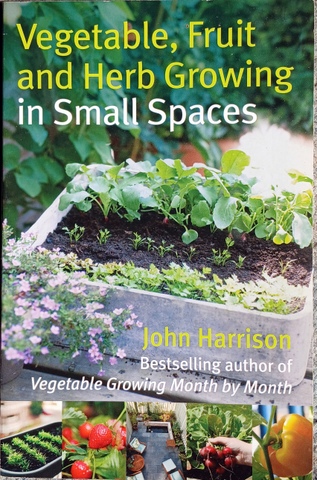
A Little Piece of Earth – Maria Finn – Universe Publishing (US) 2010 ISBN 978 0 7893 2027 8 – A great little book covering growing fruit and veggies indoors, in window boxes, on terraces and balconies in borders, patios and pergolas. The book is unusual in that it includes section on rooftop gardening, foraging and community gardening. Chapter one covers indoor and window box edibles with things like potting soil and starting seeds and unusual stuff like bananas, vanilla orchids and mushroom logs. Chapter two covers hanging gardens terraces and balconies including containers for small spaces, espaliers and the native wildlife terrace. Chapter three covers rooftop gardens including plants for the windy roof, mediterranean lounge garden and French intensive gardening. Chapter four is about the spaces between: borders, patios and pergolas, including a kids garden, an Asian mixed veg planter and an outdoor kitchen with edible walls, Chapter five is foraging and chapter six is community gardening. There are also recipes and DIY scattered throughout the book. No photos but some line drawings.
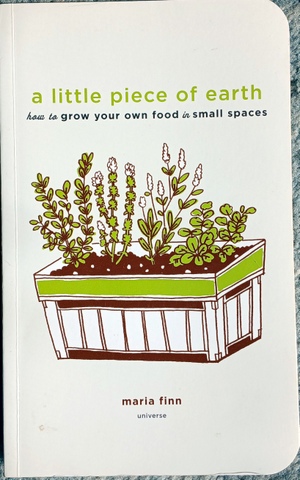
Indoor Growing
The Apartment Farmer (The Hassle Free Way to Grow Vegetables Indoors, on Balconies, Patios, Roofs and in Small Yards) – Duane Newcombe – J.P. Archer Inc. (US) 1976 ISBN 0 87477 047 5 – If you can get hold of, this is a good one. Lots of info about growing under lights and in containers and good detail on individual vegetables. The book starts out with what apartment farming can do, why it is worthwhile, where you can find the space and planning things out. This is followed by a chapter soil, water and planting considerations, then moves on to growing in particular areas: the windowsill, balcony, patio, rooftop, and then indoors using artificial lighting. The last four chapters discuss the fruits, vegetables and herbs suitable for this approach. The book has no photos, but lots or really good line drawings.
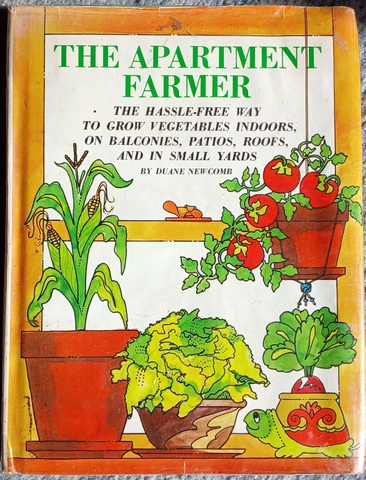
Escarole in the Bedroom (Growing Food Plants Indoors) – Jack Kramer – Little, Brown and Co (US) 1977 ISBN 0 316 50314 2 – As well as some good detail on how to grow individual food crops, this book provides some interesting information on areas to grow the plants indoors, using artificial light and what sort of containers to use. Chapter one covers the fundamentals of growing food indoors (watering, feeding pests and diseases), chapter two covers seed sowing, chapter three gives some insight into where to grow plants indoors, room by room and chapter four talks about containers that can be used, pots and recycled containers. Chapter five covers using artificial light for indoor growing. Chapter six talks about sprouting and some herbs, chapter seven talks about growing summer veg and chapter eight covers fruit and autumn plantings. Chapter nine covers processes for growing plants in the (US) winter and chapter ten talks about food plants that can be grown all year round including 10 herbs, 4 sprouts 12 vegetables, 11 fruit and some other miscellaneous crops. Each entry gives an introduction, summary of growing info (spacing, germination, how to grow, harvesting, varieties etc.) and with some there are recipes. There are no photos but lots of line drawings.
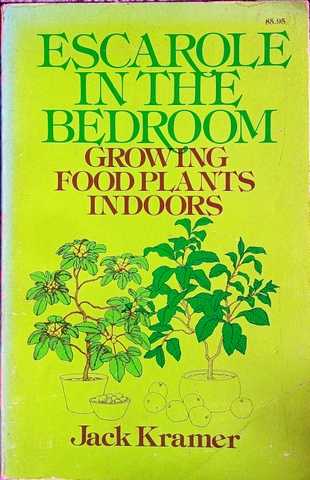
Indoor Kitchen Gardening – Elizabeth Millard – Cool springs Press (US) 2014 ISBN 978 1 59186 593 3 – After an introduction, the book is broken up into three main sections. The first section, growing edibles indoors, talks about planning your approach, working out where to grow your indoor crops taking into account space, light, humidity, pets and pests, working out what containers and growing medium you need, plus lighting and air movement, what seeds you need, problems you may face like mould and pests and having the right attitude around indoor growing. The second section provides information on growing sprouts and microgreens, herbs, wheatgrass and mushrooms. The section is quite detailed, giving an oveerveiw of production techniques, requirements and likely problems and how to deal with them. Section Three, in a similar process to section two discusses growing radishes, carrots, tomatoes, leaf crops, potatoes and capsicums indoors. It is a well written and informative book with lots of colour photos.
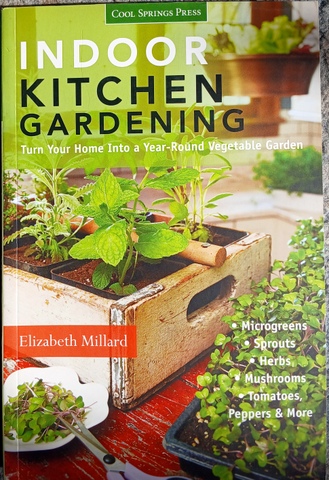
Indoor Edible Garden – Zia Allaway – DK Penguin Random House (UK) 2017 ISBN 978 0 2412 4897 3 – The book has six chapters and in general terms there are so many (very attractive) colour photos that the actual amount of information on each page adds up to a few paragraphs or less. Chapter one covers planning the indoor edible garden, and talks about where to grow edibles including detail on identifying sunlit, partial sunlit and cool zones, best indoor edibles and choosing a container. Chapter two gives details on growing herbs and edible flowers, chapter three covers sprouts, leaves and roots including sprouts and microgreens, mushrooms, leaf and root vegetables. Chapter four gives details on fruiting vegetables eg tomatoes, cucumbers and capsicums, chapter five covers fruit including curry leaves, strawberries and peaches and nectarines. Chapter six provides ‘Expert’s Tips’ on indoor growing, including planning, watering, pruning and training, pests and diseases. As previously mentioned, the book has lots of colour photos.
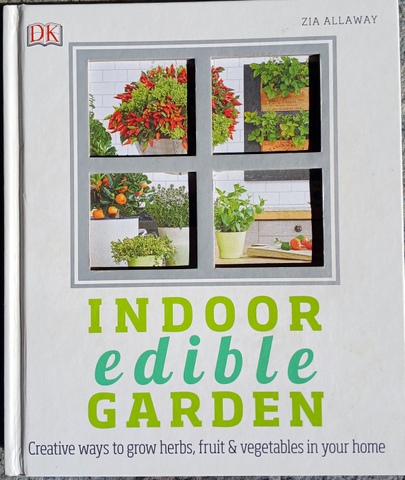
Edible House Plants – Laurelynn G. Martin & Byron E. Martin – Storey Publishing (US) 2023 ISBN 978 1 63586 678 0 – The book is divided up into the introduction and five parts, The introduction provides a small colour drawing off all of the plants referred to in the main part of the book. Part one covers 15 citrus fruits, part two covers ‘the rest of the tropical fruit basket’ or 23 tropical fruits including avocado, banana, fig, miracle berry (?), peanut butter fruit (??) and pineapple. Part four covers coffee, tea and chocolate (4 plants) and part five covers sugar and spices (4 plants). Each plant entry is two pages long and introduces the plant, suggested varieties and plant particulars such as size, bloom season and fruiting season, followed by short notes on growing conditions, care and potential problems (ie pests and diseases), the rest of the two pages being taken up with large colour photos. Part five discusses plant care including getting started by choosing your containers and repotting, followed by maintaining plants by feeding and watering, pollinating and pruning, after which is a more in depth discussion of pests and diseases and a troubleshooting guide. As mentioned previously, there are lots of colour photos.
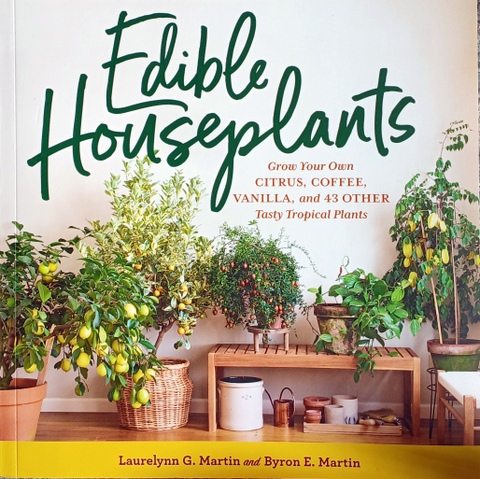
Re-Growing from Plant Material
The After Dinner Gardening Book – Richard W. Langer – Collier Books (US) 1971 ISBN 0 89815 450 2 – This is a quirky little paperback about how a bloke in an apartment in New York grew his own productive jungle from planting material he got from his local greengrocer. There are twenty four chapters and most tell the story of his working to grow a plant in his apartment and what he learned eg ‘the inscrutable Chinese Gooseberry’ and ‘lots of yams please, I am not on a diet . The author is a great storyteller and has other books on growing plants out there, plus several on using a bread baking machine! No photos but the odd line drawing.
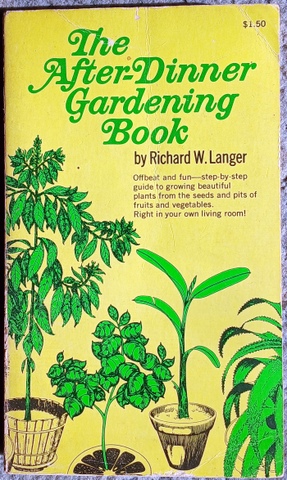
Don’t Throw it, Grow it! – Deborah Peterson and Millicent Selsam – Storey Publishing (US) ISBN 978 1 60342 064 8 – Similar in thrust to the After Dinner Gardening Book above, the by-line says it all – 68 windowsill plants from kitchen scraps. Chapter one covers growing techniques including what plants need to grow and caring for new plants/ Chapter two is about regrowing 13 plants from common veg like beets, onions and radishes. Chapter three is about regrowing 15 plants from fruits and nuts like fig, feijoa and pineapple. Chapter four is about regrowing 9 plants from herbs and spices like anise, dill and fennel. Chapter Five is about regrowing 10 plants from Latin America including choko!!!! And Chapter six covers 14 plants from Asia including arrowhead, ginger and taro. No photos but lots of line drawings.
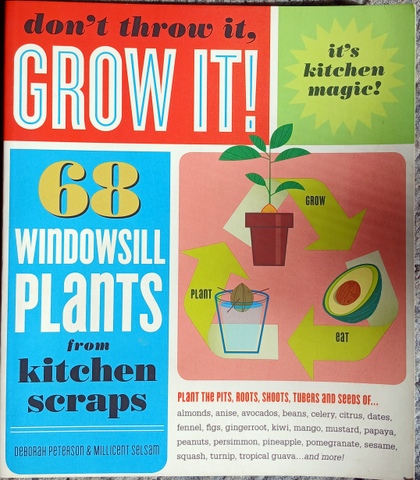
Plants from Pits – Holly Farrell – Mitchell Beasly (Octopus Publishing) (UK) 2015 ISBN 978 1 78472 103 9 – As the name suggests, the book is about how to extract seeds from kitchen scraps and grow them on in pots to produce food. The book has four chapters, chapter one deals with how plants grow from ‘pits’ contained withing their fruit. Chapter two covers growing the pits successfully including what to grow where, basic tools required, which ones grow indoors and which grow outdoors, sowing watering and feeding them. Chapter three discusses the method of growing from 36 separate plant pits and chapter four covers looking after the plants as they grow including issues such as repotting, planting out, keeping plants to size, supporting tall plants, pests, diseases and other problems. The plant has lots of colour photos and some line drawings.
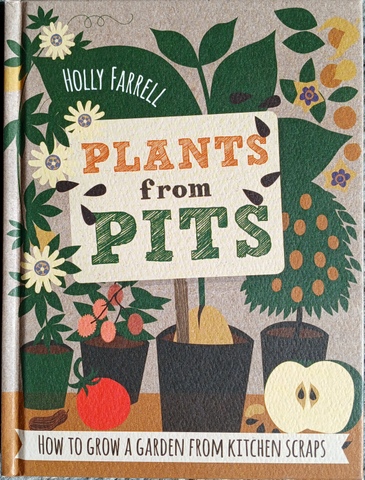
65 House Plants From Seeds, Pits and Kernels – Ralf Efraimsson – Woodbridge Press Publishing Company (US) 1977 ISBN 0 912800 40 2 – The book is divided into two parts, Part 1 – the basics, covers what is a plant, what is a seed or pit, requirements for growing (pots, soil, fertiliser, water air) and techniques for planting, transplanting, pruning, artificial lighting, pests and diseases. Part 2 provides the details for each separate plant, bit not a huge amount of detail, 1 to 2 pages per plant including bananas, beans, cherimoya, coffee, guava, hazelnut, lemon, melon, onion, orange, pepper, rice, rose apple and walnut. No photos, some line drawings.
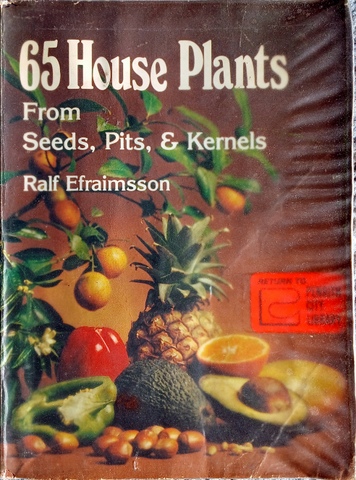
No Waste Kitchen Gardening – Katie Elzer-Peters – Cool Springs Press (US) 2018 ISBN 978 0 7603 6160 3 – The book is divided into an introduction and 5 chapters, the intro covers why you might want to do it and chapter one covers how it works, discussing the parts of a plant in some detail, how plants grow and ways to regrow them as well as tools and materials required and plant propagation techniques. Following chapters cover individual plants and how they may be regrown, in simple steps. Chapter two covers how to regrow roots and underground stems in soil eg potatoes, carrots and turnips; chapter three covers regrowing stems and modified stems in soil such as garlic, shallots and leeks; Chapter four covers growing seeds in soil and water including pumpkins, citrus and tomatoes; and chapter 5 covers regrowing whole plants and stems in water including lettuce, celery and green onions. Lots of colour photos.



